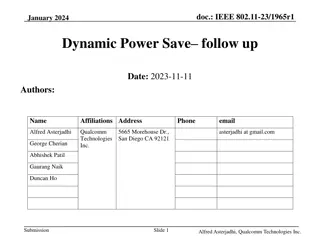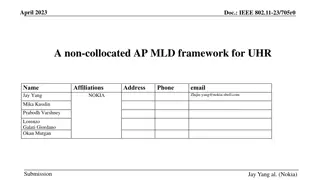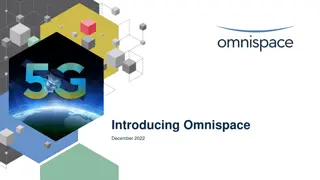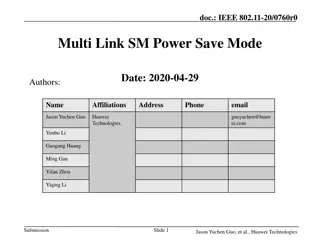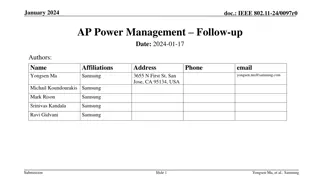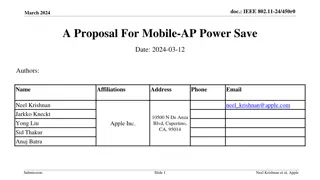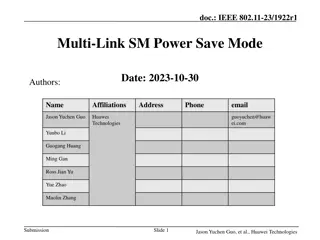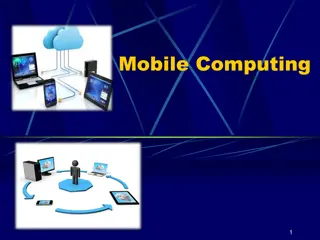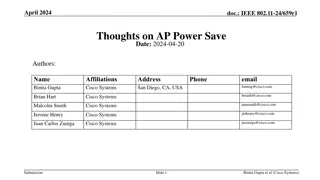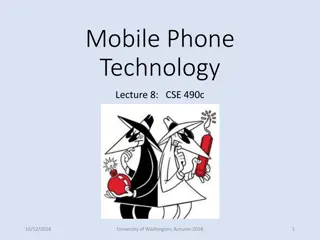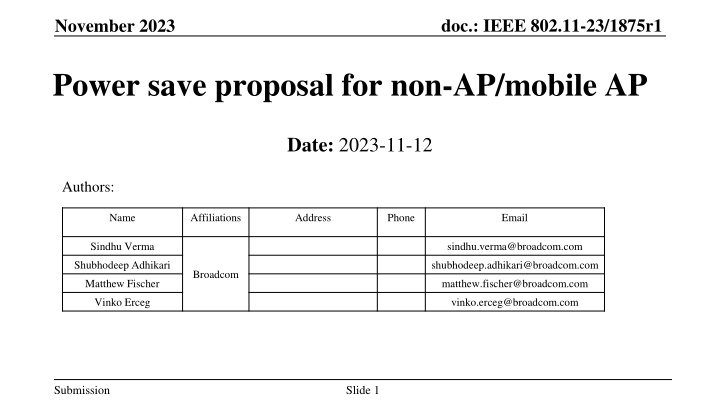
IEEE 802.11-23/1875r1 Power Saving Proposal for Non-AP and Mobile AP
Proposal to reduce power consumption in non-AP and mobile AP devices through optimized listen, receive, and triggered transmit modes. Addresses key power consumption components and suggests a high-level solution for efficient power management.
Download Presentation

Please find below an Image/Link to download the presentation.
The content on the website is provided AS IS for your information and personal use only. It may not be sold, licensed, or shared on other websites without obtaining consent from the author. If you encounter any issues during the download, it is possible that the publisher has removed the file from their server.
You are allowed to download the files provided on this website for personal or commercial use, subject to the condition that they are used lawfully. All files are the property of their respective owners.
The content on the website is provided AS IS for your information and personal use only. It may not be sold, licensed, or shared on other websites without obtaining consent from the author.
E N D
Presentation Transcript
doc.: IEEE 802.11-23/1875r1 November 2023 Power save proposal for non-AP/mobile AP Date: 2023-11-12 Authors: Name Affiliations Address Phone Email Sindhu Verma sindhu.verma@broadcom.com Shubhodeep Adhikari shubhodeep.adhikari@broadcom.com Broadcom Matthew Fischer matthew.fischer@broadcom.com Vinko Erceg vinko.erceg@broadcom.com Submission Slide 1
doc.: IEEE 802.11-23/1875r1 Abstract This is a proposal to reduce the power consumption at a non-AP in listen, receive and triggered transmit modes. The proposal can also be used at a mobile AP and optionally an AP. Submission Slide 2
doc.: IEEE 802.11-23/1875r1 Overview Problem Statement High-level Solution References Straw Poll Submission Slide 3
doc.: IEEE 802.11-23/1875r1 Problem Statement (1) For most typical usage models and over a long term average, the listen operation, when a non-AP is awake and prepared to receive or transmit data, but when it is not actually receiving or transmitting such data, contributes to the largest component of power consumption at the non-AP. In terms of power, the next two largest components are Receive and Transmit (which of these consumes more power depends on the usage model). A non-AP has to be in listen mode often with its full bandwidth, NSS and MCS capabilities. An ML non-AP often has to be in listen mode over all the links that it operates on. Further, in receive mode and in triggered transmission mode, a non-AP has to be prepared to receive or transmit with its full bandwidth, NSS and MCS capabilities. Submission Slide 4
doc.: IEEE 802.11-23/1875r1 Problem Statement (2) If the AP could provide a-priori information to the non-AP regarding the number of spatial streams, bandwidth and maximum MCS over which the non-AP has to receive or transmit data, it could significantly reduce the power consumption in listen, receive and triggered transmission modes. Dynamic SM Power Save is not enough; as a non-AP can listen with 1 NSS, but: It still has to listen over its full bandwidth and over all the links that it operates on. Further, on receiving the initial frame, the non-AP has to always transition to a state where it is capable of receiving PPDUs over its full bandwidth, NSS and MCS. This is wasteful in terms of power consumption, as in the ensuing frame exchange, the non-AP may not receive or transmit PPDUs with all its RF chains, maximum MCS and full bandwidth. Submission Slide 5
doc.: IEEE 802.11-23/1875r1 High-level Solution (1) Define a protocol similar to the listen operation in EMLSR mode, optimize it further for higher power savings and extend the protocol all non-AP modes. The non-AP and AP select a link (optionally a set of links) on which the non-AP will be in listen mode. In this mode, a non-AP listens for only 20MHz PPDUs with low MCS (suggest non-HT duplicate PPDUs) over the selected link(s). When an AP wants to initiate frame exchanges with the non-AP in a wideband manner, it first transmits such a 20MHz PPDU addressed to the non-AP on the selected link(s). This frame is termed as the Initial Control Frame (ICF). Submission Slide 6
doc.: IEEE 802.11-23/1875r1 High-level Solution (2) The ICF contains the following information, based on capability negotiation between the AP and the non-AP: the bandwidth, NSS and max MCS on these links on which the non- AP should be ready to receive or transmit triggered data. The ICF also contains a configurable padding. This padding provides the time required by the non-AP to switch from listen-mode on the link(s) on which it receives the ICF to being Rx/Tx capable on the link(s) and their respective bandwidths/NSS/max MCS. Similar to EMLSR, the padding may consist of information/data directed to other non-APs, the duration of which this non-AP can utilize to perform the switch. Once the non-AP receives such an ICF, it prepares itself for Rx/Tx on the link(s) with their indicated bandwidths/NSS/max MCS Submission Slide 7
doc.: IEEE 802.11-23/1875r1 High-level Solution (3) The non-AP may optionally transmit a response frame on these links once it is ready for frame exchanges with the AP. The AP initiates frame exchanges with the non-AP on the link(s)/bandwidths/NSS/max MCS indicated in the ICF. Conditions are defined (similar to EMLSR/EMLMR) after which the non-AP switches back to 20MHz listen mode on the selected link(s). Submission Slide 8
doc.: IEEE 802.11-23/1875r1 Potential power saving For listen operation, it would suffice for the non-AP to remain in 20MHz 1 NSS low MCS mode. For Receive and Triggered transmit operation, a non-AP need not power up all chains on all links and at the maximum bandwidth and MCS capabilities. Based on the information provided by the AP in the ICF, the non-AP needs to transition only to the state that is sufficient to receive or transmit the subsequent frame exchanges. Submission Slide 9
doc.: IEEE 802.11-23/1875r1 References IEEE 802.11-23/1134r0, LB271 CR for MLSM Power Save Mode: Jason Yuchen Guo et al, Huawei IEEE 802.11-22/1414r1, Low Power Listening Mode, Xiaogang Chen et al, Zeku. IEEE 802.11-22/1841r0, Follow up on the low power listening mode, Xiaogang Chen et al, Zeku. IEEE P802.11be /D5.0 Submission Slide 10
doc.: IEEE 802.11-23/1875r1 Straw Poll Do you support to define a power save mode for a UHR non-AP or a mobile AP, where the non-AP or mobile AP may transition from a lower capability mode to a higher capability mode upon reception of an Initial Control Frame The type and format of the Initial Control frame is TBD It is TBD whether such a power save mode can be extended to a non-mobile AP. Submission Slide 11


